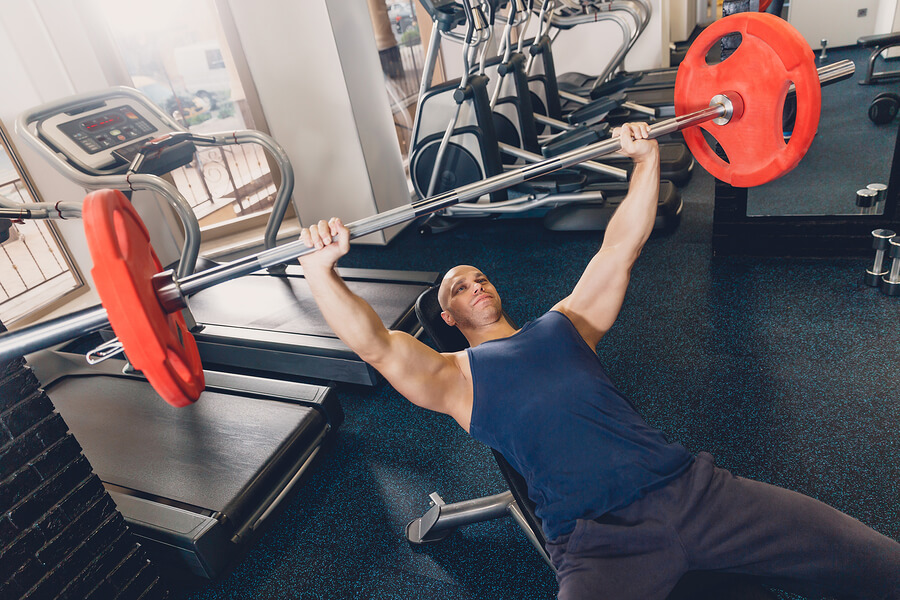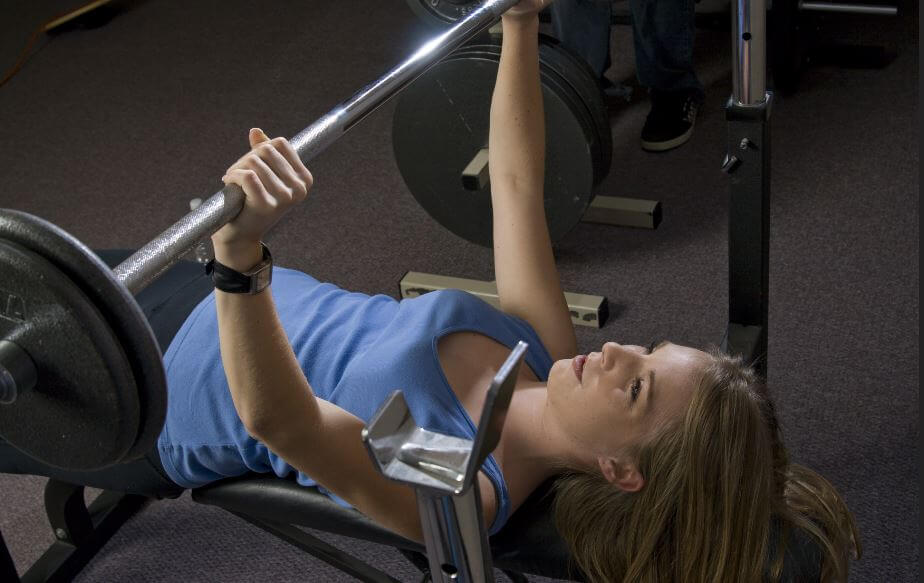Bench Press Variants

The bench press is a competitive weightlifting exercise, it’s also a great resource for people who want to practice bodybuilding. Beyond this, it represents an indispensable tool that can provide an improvement in almost every sport. What are the different positions to perform on the bench press?
Over the years, the technical aspects have been perfected and many new ways have been developed to carry out this exercise. This has allowed for improvements in other areas of the body and increased stimulation of the predominant muscles that are used in the exercise.
It’s important to know the correct basic bench press technique and its benefits. Read along to find out more about secondary aspects, such as the grip and position of the chest and lower body.
The evolution of the grip on the bench press
In regard to the grip, it’s been shown that, for correct pectoral stimulation, the distance between your hands on the bar should be approximately the distance between your shoulders multiplied by 1.5.
Of course, you could select a wider grip in order to prepare the body for functional movements based on that amplitude. You can even carry out the exercise with a closed grip in order to stimulate the triceps even more.
Everything depends on your objectives. It’s important to take the possible consequences of each position into account before making a decision. However, at the end of the day, the more variability you add to your workouts, the greater the benefits you’ll receive.

Chest variations
If there’s one thing we know about the world of fitness, it’s that many theories that were once supreme law become obsolete within a few years. Therefore, it’s best to find the most up to date theories in order to experience the most benefits.
Different ways of thinking
There’s still a lot of debate about the ‘correct’ position of the chest and back. New techniques show an improvement in lifting with a slightly unnatural lumbar and thoracic arch.
However, is it wise for an untrained person to perform variation since it will put a lot of pressure on their intervertebral discs? The answer is no, in order to select an appropriate variant, you must take your individual characteristics into account.
That’s also why there are many opinions linked to health and not performance. Most people agree that it’s best to have a comfortable solid bench. From a comfortable bench, you’ll be able to focus all of your attention on arm extensions and muscle contractions.
Make solid progress
You may have questions about how long it’ll take to reach the desired results, and of course, the correct weights to carry. Once you reach a certain level, you’ll be able to bench press huge loads.
In order to make progress, it’s important to perfect your technique and execution speed. You should also pay attention to structural health.
The support of the lower train bench press
What if we said that pedal support is not always necessary? The bench press is an exercise that can be performed with a guided machine. With guided machines, there’s no destabilization that can sometimes be created when the bar is suspended in your hands.

Unstudied alternatives
The metal arms of the guided machine can allow you to express your creativity, for example, by increasing lower train extension. This should be done isometrically to strengthen the lumbar-abdominal zone. This will effectively transform the bench press into a mixed workout that doesn’t only focus on a single muscle.
In conclusion, working integrally, while keeping your vision and professional advice, you’ll be able to make micro improvements to your workout. In the fitness world, there are many useful training systems that can be improved. There’s no supreme law. The bench press is not an exception, that’s why new variants are being developed to make training more effective.
The bench press is a competitive weightlifting exercise, it’s also a great resource for people who want to practice bodybuilding. Beyond this, it represents an indispensable tool that can provide an improvement in almost every sport. What are the different positions to perform on the bench press?
Over the years, the technical aspects have been perfected and many new ways have been developed to carry out this exercise. This has allowed for improvements in other areas of the body and increased stimulation of the predominant muscles that are used in the exercise.
It’s important to know the correct basic bench press technique and its benefits. Read along to find out more about secondary aspects, such as the grip and position of the chest and lower body.
The evolution of the grip on the bench press
In regard to the grip, it’s been shown that, for correct pectoral stimulation, the distance between your hands on the bar should be approximately the distance between your shoulders multiplied by 1.5.
Of course, you could select a wider grip in order to prepare the body for functional movements based on that amplitude. You can even carry out the exercise with a closed grip in order to stimulate the triceps even more.
Everything depends on your objectives. It’s important to take the possible consequences of each position into account before making a decision. However, at the end of the day, the more variability you add to your workouts, the greater the benefits you’ll receive.

Chest variations
If there’s one thing we know about the world of fitness, it’s that many theories that were once supreme law become obsolete within a few years. Therefore, it’s best to find the most up to date theories in order to experience the most benefits.
Different ways of thinking
There’s still a lot of debate about the ‘correct’ position of the chest and back. New techniques show an improvement in lifting with a slightly unnatural lumbar and thoracic arch.
However, is it wise for an untrained person to perform variation since it will put a lot of pressure on their intervertebral discs? The answer is no, in order to select an appropriate variant, you must take your individual characteristics into account.
That’s also why there are many opinions linked to health and not performance. Most people agree that it’s best to have a comfortable solid bench. From a comfortable bench, you’ll be able to focus all of your attention on arm extensions and muscle contractions.
Make solid progress
You may have questions about how long it’ll take to reach the desired results, and of course, the correct weights to carry. Once you reach a certain level, you’ll be able to bench press huge loads.
In order to make progress, it’s important to perfect your technique and execution speed. You should also pay attention to structural health.
The support of the lower train bench press
What if we said that pedal support is not always necessary? The bench press is an exercise that can be performed with a guided machine. With guided machines, there’s no destabilization that can sometimes be created when the bar is suspended in your hands.

Unstudied alternatives
The metal arms of the guided machine can allow you to express your creativity, for example, by increasing lower train extension. This should be done isometrically to strengthen the lumbar-abdominal zone. This will effectively transform the bench press into a mixed workout that doesn’t only focus on a single muscle.
In conclusion, working integrally, while keeping your vision and professional advice, you’ll be able to make micro improvements to your workout. In the fitness world, there are many useful training systems that can be improved. There’s no supreme law. The bench press is not an exception, that’s why new variants are being developed to make training more effective.
All cited sources were thoroughly reviewed by our team to ensure their quality, reliability, currency, and validity. The bibliography of this article was considered reliable and of academic or scientific accuracy.
- Chulvi Medrano, I. y Díaz Cantalejo, A. 2008. Eficacia y seguridad del press de banca: revisión. Revista Internacional de Medicina y Ciencias de la Actividad Física y el Deporte vol.
8 (32) pp. 338-352 Http://cdeporte.rediris.es/revista/revista32/arteficacia103.htm - Ejercicios para el tren superior: pectorales. AMICI. http://www.amicivirtual.com.ar/assets/files/musculacion/7ejercicios%20para%20miembro%20superior.pdf
This text is provided for informational purposes only and does not replace consultation with a professional. If in doubt, consult your specialist.








